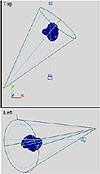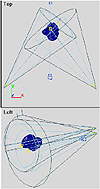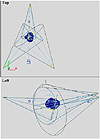| ISO 9000 | ISO 14000 | Forum |
| Mastering 3D Studio MAX R3 |
| Previous | Table of Contents | Next |
Using Advancing and Receding Colors
The eye can be tricked into seeing certain colors “pop out” toward the foreground while other colors are seen to recede. Use red colors to emphasize an object or make it pop forward; use blue in the background for elements that you want to recede from the camera. This optical illusion is the result of the differing wavelengths of red and blue light. Using reds and blues in the same scene can accentuate this effect and give your scenes added depth.
Using Contrast and Harmony
Another way to increase the perception of depth in your scene is to employ the color shift principle. By shifting the color of a shadow toward the complementary color of the light, you increase the depth of your shadows. Let’s try it on our pillars scene. We’ll start with the foreground and lights first. We want to really give this scene a warm, “magic hour,” feeling. The sunlight is low, behind us, with the water and mountains receding into the distance, creating an almost surreal feeling.
|
| |
| NOTE If you want to start from this point, open the pillars02.max file on the CD. |
- 1. Select the key light and adjust the color value
to a light yellow, with a slight red tinge.
- 2. Press Shift+E to render. There is an obvious change in the scene. Everything now has a yellowish tint.
- 3. Now go to the Shadow color swatch on the Shadow Parameters rollout and change the color to a very dark purple. Almost black, but be sure you can still tell that it is purple. You’ll probably notice that this gives everything a really purple wash. You may need to adjust this several times to minimize the harshness of this color, but we still want some purple.
- 4. Render again. Adding the tinge of complementary color to the shadow color deepens the scene slightly. Again, it may not be noticeable by itself, but used in combination with some of these other techniques, the overall quality of your scenes will seem richer and more complex.
- 5. In the Rendering Ø Environment dialog box, click in the Global Lighting Tint box. Choose a light color similar to the key light color. You might need to go a bit lighter here. This changes all the lights to that tint, giving you a much more balanced lighting set up.
- 2. Press Shift+E to render. There is an obvious change in the scene. Everything now has a yellowish tint.
|
| |
| NOTE You can see a completed version of this scene in pillars03.max on the CD. |
Painting Light and Shadows
Painting light and shadows involves using black and white lights to define the values in the scene more precisely than with the simulated illumination of a single light. In other words, you “paint” with light itself. For example, say you were creating a clearing in a dense forest, streaming with golden sunlight. You might have a brighter, white Omni light illuminating where the light hits the forest floor, with several other Omnis with negative multiplier values (sucking out the light) placed to darken the more remote areas of the camera view.
|
| |
| NOTE Only black and white lights should be used with this technique, because negative lights remove color as well as intensity. Using a negative colored light would shift the remaining light to its complementary color. |
Designing Your Lighting
Through many decades of study and experimentation with lighting, certain conventions have developed that can give you a starting point for your lighting setup. It’s useful to learn these conventions so that you can avoid reinventing the wheel and adapt them to the specific needs of your scene.
Using a Three-Point Light Setup
The three-point light setup is a classic arrangement of lights, including a key light, a fill light, and a back or kicker light. You may ultimately have many more than three lights in your scene, yet setting the three basic points can give you a good basis from which to start.
Key Light
A key light is the primary light of a particular setup; it’s the brightest light and provides the bulk of light for any particular object. Fill and back lights should therefore have lower multiplier values than your key light. A key light is generally placed above the subject and about 45ј off of the center line from the camera to the subject, to add depth (Figure 10.8 shows a typical placement). The position of the key light may need to be altered based on the number of objects you are lighting, the time of day, whether it is an indoor or outdoor scene, and the mood you’re trying to create. You need to experiment to acquire the kind of experience that will help you here.

FIGURE
10.8 Key light placement, top and side views
In CG, the key light can also be the sun. You may find that you need more than one light to simulate the sun in your scene.
Fill Light
A fill light provides some diffuse light to areas that would be completely dark with only the key light. If you have one key light in the scene illuminating a face, for example, one side of the face will be well lit while the other side will be cast in stark shadow. You want to be able to see the other half of the face, but also keep some of the shadow created by the key light for depth. You use a lower multiplier value (about 40 to 60 percent of the key light) so that you don’t wash out the key light, only fill in some shadow areas with light.
The fill light is generally placed lower and opposite to the key light (Figure 10.9 shows a typical placement). Again, you may need to adapt this to fit the needs of your scene. You may need several fill lights.
Back Light
The back light, or kicker, is generally placed above and behind the object, out of the camera view (see Figure 10.10). Its purpose is to illuminate the top edge or surface of an object, giving the image depth and preventing the lit object from looking like a cutout against the background.
|
| |
| NOTE You can see this file on the CD as 3_point.max. |

FIGURE
10.9 Fill light, with key light, top and side
views

FIGURE
10.10 Back light with key and fill lights, top
and side views
Zone Lighting
Zone lighting is useful when your character will be moving through a large scene. You create zones of light for the character to move through, with areas of low light providing variety and contrast rather than having a general level of light for a whole scene. This is a bit like spotlighting on a stage; it focuses the attention of your audience in specific areas and can add drama to an unfolding story.
| Previous | Table of Contents | Next |
© 2000, Frol (selection, edition, publication)
|
|
